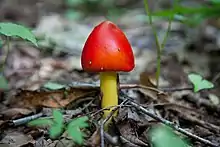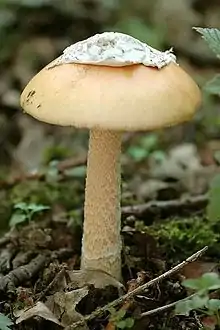Amanita jacksonii
Amanita jacksonii is a species of fungus in the family Amanitaceae. It is a reddish-orange colored mushroom species extending from the Province of Quebec, Canada to at least the State of Hidalgo, Mexico. It was given its current name in 1984 by Canadian mycologist René Pomerleau.[2][3] It can be identified by its yellow gills, large, white, sacklike volva, and bright orange or orange red cap, which has lined margins.[4]
| Amanita jacksonii | |
|---|---|
 | |
| A newly emerged, growing A. Jacksonii. | |
| Scientific classification | |
| Kingdom: | Fungi |
| Division: | Basidiomycota |
| Class: | Agaricomycetes |
| Order: | Agaricales |
| Family: | Amanitaceae |
| Genus: | Amanita |
| Species: | A. jacksonii |
| Binomial name | |
| Amanita jacksonii | |
| Synonyms[1] | |
|
Amanita umbonata Pomerl. | |
| Amanita jacksonii | |
|---|---|
float | |
| gills on hymenium | |
| cap is flat or convex | |
| hymenium is free | |
| stipe has a ring and volva | |
| spore print is white | |
| ecology is mycorrhizal | |
| edibility: choice but not recommended | |
Description
The cap of the mushroom is 8–12 cm, 80 – 120 mm wide; oval at first, becoming convex, typically with a central bump; sticky; brilliant red or orange, fading to yellow on the margin; typically without warts or patches; the margin lined for about 40-50% of the cap's radius. The red pigment fades from margin toward the center with age.[5] Gills are moderately crowded to crowded, orange-yellow to yellow-orange to yellow. They are free from the stem or slightly attached to it; yellow to orange-yellow; crowded; not bruising. The short gills are subtruncate to truncate. Its stipe or stem (90 - 140 × 9 – 16 mm) is yellow and is decorated with orange fibrils and patches that are the remnants of a felted extension of the limbus internus of the otherwise white volva. The spores measure (7.0-) 7.8 - 9.8 (-12.1) × (5.2-) 5.8 - 7.5 (-8.7) μm and are broadly ellipsoid to ellipsoid (rarely subglobose or elongate) and inamyloid. Clamps are common at bases of basidia.[6] Flesh looks whitish to pale yellow; not staining on exposure.
The mushroom is generally considered edible and enjoyed by some, although it can be misidentified with other species.
See also
References
- "Amanita jacksonii - Amanitaceae.org - Taxonomy and Morphology of Amanita and Limacella". www.amanitaceae.org. Retrieved 21 September 2017.
- Mushroom Observer-Amanita jacksonii Pomerleau https://mushroomobserver.org/name/show_name?_js=on&_new=true&id=1067
- Pomerleau R. (1984). "A propos du nom scientifique de l'oronge américaine". Naturaliste Canadien (in French). 111 (3): 329–30.
- Kuo, M. (2008, March). Amanita jacksonii. Retrieved from the MushroomExpert.Com Web site: http://www.mushroomexpert.com/amanita_jacksonii.html
- http://www.eticomm.net/~ret/amanita/species/jacksoni.html Archived 2011-07-16 at the Wayback Machine By R. E. Tulloss.
- http://www.amanitaceae.org/index.php?Amanita%20jacksonii Amanita jacksonii-www.amanitaceae.org

